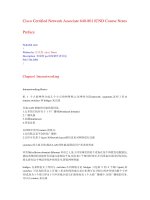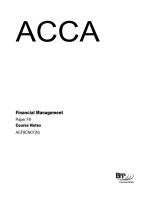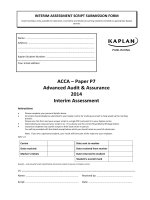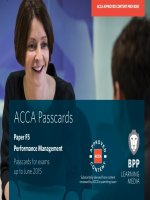ACCA p7 BPP COURSE NOTES
Bạn đang xem bản rút gọn của tài liệu. Xem và tải ngay bản đầy đủ của tài liệu tại đây (2.92 MB, 292 trang )
Advanced Audit and
Assurance
Paper P7 (Global)
Course Notes
ACP7CN07
l
P7 Advanced Audit and Assurance
(Global)
Study Programme
Page
Introduction to the paper and the course............................................................................................................... (ii)
1
2
3
4
5
International regulatory environments for audit and assurance services .................................................... 1.1
Code of ethics and conduct......................................................................................................................... 2.1
Professional liability..................................................................................................................................... 3.1
Quality control ............................................................................................................................................. 4.1
Obtaining and accepting professional appointments................................................................................... 5.1
End of Day 1 – refer to Course Companion for
6
7
8
9
10
11
Home Study
Progress test 1
Planning and risk assessment..................................................................................................................... 6.1
Evidence...................................................................................................................................................... 7.1
Evaluation and review ................................................................................................................................. 8.1
Evaluation & review (ii) matters relating to specific accounting issues........................................................ 9.1
Evaluation & review (iii) matters relating to specific accounting issues..................................................... 10.1
Group audits and transnational audits....................................................................................................... 11.1
End of Day 2 – refer to Course Companion for
Home Study
Progress test 2
Course exam 1
12
13
14
15
16
17
18
Audit related services and other assurance services ................................................................................ 12.1
Prospective financial information (PFI)...................................................................................................... 13.1
Forensic audits .......................................................................................................................................... 14.1
Social and environmental auditing............................................................................................................. 15.1
Internal audit and outsourcing ................................................................................................................... 16.1
Reporting .................................................................................................................................................. 17.1
Homestudy chapter – Current issues ........................................................................................................ 18.1
End of Day 3 – refer to Course Companion for
Home Study
Progress test 3
Course exam 2
19
20
21
Answers to Lecture Examples ................................................................................................................... 19.1
Question and Answer bank ....................................................................................................................... 20.1
Appendix A: Pilot Paper questions ............................................................................................................ 21.1
Don’t forget to plan your revision phase!
•
•
•
•
Revision of syllabus
Testing of knowledge
Question practice
Exam technique practice
BPP provides revision courses, question days,
mock days and specific material to assist you in
this important phase of your studies.
(i)
INTRODUCTION
Introduction to Paper P7 Advanced Audit and Assurance
(Global)
Overall aim of the syllabus
To develop knowledge and skills in understanding and applying accounting standards and the theoretical
framework in the preparation of financial statements of entities, including groups and how to analyse and
interpret those financial statements.
The syllabus
The broad syllabus headings are:
A
B
C
D
E
F
Regulatory environment
Professional and ethical considerations
Practice management
Assignments
Reporting
Current issues and development
Main capabilities
On successful completion of this paper, candidates should be able to:
•
Recognise the legal and regulatory environment and its impact on audit and assurance practice
•
Demonstrate the ability to work effectively on an assurance or other service engagement within a
professional and ethical framework
•
Assess and recommend appropriate quality control policies and procedures in practice management and
recognising the auditor’s position in relation to the acceptance and retention of professional appointments
•
Identify and formulate the work required to meet the objectives of audit and non-audit assignments and
the application of the International Standards on Auditing
•
Evaluate findings and the results of work performed and drafting suitable reports on assignments
•
Understand the current issues and developments relating to the provision of audit-related and assurance
service
Links with other papers
CR (P2)
AAA (P7)
AA (F8)
This diagram shows where direct (solid line arrows) and indirect (dashed line arrows) links exist between this
paper and other papers that may precede or follow it.
The advanced audit and assurance syllabus assumes knowledge acquired in Paper F8 Audit and Assurance and
develops and applies this further in greater depth.
(ii)
INTRODUCTION
Assessment methods and format of the exam
Examiner: Lisa Weaver
The examination is a three hour paper consisting of two sections. The paper will have a global focus; no
numerical questions will be set.
Format of the Exam
Marks
Section A
Will consist of two compulsory questions which must be attempted. These
questions will be based on case study type scenarios. They will cover topics
from across the syllabus,
50 – 70
Section B
Will consist of three questions, of which two must be answered. These
questions will tend to be more focused on specific topics, such as audit reports
and quality control for example.
30 - 50
100
(iii)
INTRODUCTION
Course Aims
Achieving ACCA's Study Guide Outcomes
A
A Regulatory environment
A1 International regulatory frameworks for audit and assurance services
Chapter 1
A2 Money laundering
Chapter 1
A3 Laws and regulations
Chapter 1
B
Professional and ethical considerations
B1 Code Of Ethics
Chapter 2
B2 Fraud and error
Chapter 3
B3 Professional liability
Chapter 3
C
Practice management
C1 Quality control
Chapter 4
C2 Advertising, publicity, obtaining professional work and fees
Chapter 5
C3 Tendering
Chapter 5
C4 Professional appointments
Chapter 5
D
Assignments
D1 The audit of historical financial information including:
(i) Planning, materiality and assessing the risk of statement
(ii) Evidence
(iii) Evaluation and review
Chapter 6
Chapter 7
Chapters 8-10
D2 Group audits
Chapter 11
D3 Audit-related services
Chapter 12
D4 Assurance services
Chapter 12
D5 Prospective financial information
Chapter 13
D6 Forensic audits
Chapter 14
D7 Internal audit
Chapter 16
D8 Outsourcing
Chapter 16
(iv)
INTRODUCTION
E
Reporting
E1
Auditor’s report
Chapter 17
E2
Reports to management
Chapter 17
E3
Other reports
Chapter 12
F
Current issues and developments
F1
Professional, ethical and corporate governance
F2
Information technology
Chapter 12
F3
Transnational audits
Chapter 11
F4
Social and environmental auditing
Chapter 15
F5
Other current issues
Chapters 1-3
Chapters 1, 6 &
11
(v)
INTRODUCTION
Classroom tuition and Home study
Your studies for BPP consist of two elements, classroom tuition and home study.
Classroom tuition
In class we aim to cover the key areas of the syllabus. To ensure examination success you will need to spend
private study time reinforcing your classroom course with question practice and reviewing areas of the Course
Notes and Study Text.
Home study
To support you with your private study BPP provides you with a Course Companion which helps you to work at
home and aims to ensure your private study time is effectively used. The Course Companion includes a Home
Study section which breaks down your home study by days, one to be covered at the end of each day of the
course. You will find clear guidance as to the time to spend on various activities and their importance.
You are also provided with progress tests and two course exams which should be submitted for marking as they
become due.
These may include questions on topics covered in class and home study.
BPP Learn Online
Come and visit the BPP Learn Online free at www.bpp.com/acca/learnonline for exam tips, FAQs and syllabus
health check.
ACCA Forum
We have thriving ACCA bulletin boards at www.bpp.com/accaforum. Register and discuss your studies with
tutors and students.
Helpline
If you have any queries during your private study simply contact your class tutor on the telephone number or
e-mail address that they will supply. Alternatively, call +44 (0)20 8740 2222 (or your local training centre if
outside the London area) and ask for a tutor for this paper to speak to you or to call you back within 24 hours.
Feedback
The success of BPP’s courses has been built on what you, the students tell us. At the end of the course for each
subject, you will be given a feedback form to complete and return.
If you have any issues or ideas before you are given the form to complete, please raise them with the course
tutor or relevant head of centre.
If this is not possible, please email
(vi)
INTRODUCTION
Key to icons
Question practice from the Study Text
This is a question we recommend you attempt for home study.
Real world examples
These can be found in the Course Companion.
Section reference in the Study Text
Further reading is needed on this area to consolidate your knowledge.
Formula to learn
Formula given in exam
(vii)
INTRODUCTION
(viii)
International regulatory
environments for audit
and assurance services
Syllabus Guide Detailed Outcomes
Having studied this chapter you will be able to:
•
Explain the need for laws, regulations, standards and other guidance relating to audit, assurance and related
services.
•
Outline and explain the legal and professional framework.
•
Discuss the effectiveness of the different ways in which the audit profession and audit markets are regulated.
•
Define money laundering and explain how international efforts seek to combat money laundering.
•
Explain the scope of criminal offences of money laundering and how professional accountants may be protected
from criminal and civil liability.
•
Explain the need for ethical guidance in this area.
•
Describe how accountants meet their obligations to help prevent and detect money laundering and explain the
importance of customer due diligence (Know your customer (KYC) information).
•
Recognise potentially suspicious transactions and assess their impact on reporting duties.
•
Describe with reasons the basic elements of an anti-money laundering programme.
•
Compare and contrast the respective responsibilities of management and auditors concerning compliance with
laws and regulations in an audit of financial statements.
•
Describe the auditor’s considerations of compliance with laws and regulations and plan audit procedures when
possible non-compliance is discovered.
•
Discuss how and to whom non-compliance should be reported and recognise when withdrawal from an
engagement is necessary.
•
Discuss IFAC developments including: the implementation and adoption of international standards on auditing
and significant current assurance issues being dealt with by APB/IAASB.
•
Explain how International Standards on Auditing affect smaller firms.
Exam Context
This chapter is likely to be important in the exam, particularly money laundering which was covered in the pilot paper
from both a discussion and practical context.
Business Context
An understanding of the regulatory environment and legal issues is essential for any auditor as it provides a context for
the performance of professional engagements.
1.1
1: INTERNATIONAL REGULATORY ENVIRONMENTS FOR AUDIT AND ASSURANCE
SERVICES
Overview
International regulatory
environments for audit and
assurance services
International regulatory
environment
Money laundering
The need for laws,
regulations, standards and
other guidance
Offences
ACCA guidance
1.2
ISA 250: Consideration of law
and regulations in an audit of
financial statements
1: INTERNATIONAL REGULATORY ENVIRONMENTS FOR AUDIT AND ASSURANCE
SERVICES
1
International regulatory environment
1.1
International Federation of
Accountants (IFAC)
International organisation
representing national
accountancy bodies
International Auditing and
Assurance Standards Board (IAASB)
Standing technical
committee of IFAC
issues
ASSURANCE
International Standards
on Auditing
(ISAs)
RELATED SERVICES
International Standards
on Review Engagements
(ISREs)
International Standards on
Assurance Engagements
(ISAEs)
International Standards
on Related Services
(ISRSs)
Contain
• ISRE 2400 Engagements • ISAE 3000 Assurance
• ISRS 4400 Agreed-upon
• basic principles and
to Review Financial
Procedures
Engagements
Information
essential procedures; and
• ISRS 4410 Engagements
• ISAE 3400
• related guidance
to Compile Financial
Prospective Financial
Information
Information
- explanatory notes
- other material.
Basic principles/ essential
ISAs (UK and Ireland) and are issued by the UK Auditing
procedures must be applied in
Practices Board, part of the Financial Reporting Council,
context of related guidance.
based on the international ones with additional UK-specific
guidance where desirable.
The APB has not yet adopted the IAASB's IAPSs, ISREs,
ISAEs or ISRSs.
International Auditing
Practice Statements
(IAPSs)
• Practical assistance in
implementing standards; and
• Promote good practice
1.2
The need for laws, regulations, standards and other guidance
Lecture example 1
Idea generation
Required
What factors have led to the growth in regulation of the audit profession?
1.3
1: INTERNATIONAL REGULATORY ENVIRONMENTS FOR AUDIT AND ASSURANCE
SERVICES
Solution
2
Money laundering
Definition
2.1
Money laundering is the process by which criminals attempt to conceal the true origin and
ownership of the proceeds of their criminal activity, allowing them to maintain control over
the proceeds and, ultimately, providing a cover for their sources of income.
International efforts to combat money laundering
2.2
An intergovernmental body, the Financial Action Task Force (FATF) was established in
1990 to set standards and develop policies to combat money laundering and terrorist
financing.
2.3
FATF has made 40 recommendations designed to combat money laundering and these
have been adopted by more than 130 countries.
Money laundering offences
2.4
FATF has clarified a number of criminal offences relating to money laundering. Many of
these have significant impact on the auditor and it is imperative that firms are aware of them
and consider the risk that they may be committing an offence. The key offences are as follows:
•
Possessing, dealing with or concealing criminal property.
•
Failure to report knowledge or suspicion of money laundering to the appropriate
authority (in the UK this would be the Serious Organised Crime Agency).
•
Tipping off a client of suspicions relating to money laundering or disclosing any
information that may prejudice an investigation.
1.4
1: INTERNATIONAL REGULATORY ENVIRONMENTS FOR AUDIT AND ASSURANCE
SERVICES
ACCA guidance
2.5
In order to assist members in fulfilling their obligations the ACCA has issued two technical
factsheets (94 and 131) on money laundering. The factsheets have been summarised into a
section of the ACCA’s ethical guidance which is a useful summary of members'
responsibilities. The key elements of the guidance are as follows.
Internal controls and
policies
Members should ensure their staff receive regular training to
ensure that client identification procedures are carried out
correctly and that knowledge and suspicions of money
laundering or terrorist financing are reported.
Firms should identify to their staff a clear procedure for
reporting suspected money laundering and an individual;
through whom reports of suspicions can be channelled to the
relevant authority.
Client identification
Before any work is undertaken, members should verify the
identity of the potential client.
Record keeping
Members should retain all client identification records for at
least five years after the end of the client relationship. Records
of all transactions and other work carried out, in a full audit
trail form, should be retained for at least five years after the
conclusion of the transaction.
Recognition of
suspicion
Suspicion can be described as being more than speculation
but falling short of proof based on firm evidence. The key to
recognising a suspicious transaction or situation is for
members to have sufficient understanding of clients and their
activities.
Reporting suspicious
transactions
Where members know or suspect that funds are the proceeds
of crime or relate to terrorist financing, they should promptly
report their suspicions to the relevant authority.
Tipping off
Members should not “tip off” a client that a report has been
made. If a suspicion has arisen during the course of client
identification procedures, members should take extra care that
carrying out those procedures will not tip off the client.
Lecture example 2
Exam standard for 4 marks
Required
Why is there a need for ethical guidance in respect of money laundering?
1.5
1: INTERNATIONAL REGULATORY ENVIRONMENTS FOR AUDIT AND ASSURANCE
SERVICES
Solution
3
ISA 250: Consideration of law and regulations in an
audit of financial statements
3.1
When designing and performing audit procedures and in evaluating and reporting the results
thereof, the auditor should recognise that non-compliance by the entity with law or
regulations may materially affect the financial statements.
Responsibility of management
3.2
It is management’s responsibility to ensure that the entity’s operations are conducted in
accordance with laws and regulations.
The responsibility for the prevention and detection of non-compliance also rests with
management.
3.3
The following policies and procedures, among others, may assist management in
discharging its responsibilities for the prevention and detection of non-compliance:
•
Monitoring legal requirements and any changes therein and ensuring that operating
procedures are designed to meet these requirements.
•
Instituting and operating appropriate internal control.
•
Developing, publicising and following a Code of Conduct.
•
Ensuring employees are properly trained and understand the Code of Conduct.
•
Monitoring compliance with the Code of Conduct and acting appropriately to discipline
employees who fail to comply with it.
•
Engaging legal advisers to assist in monitoring legal requirements.
•
Maintaining a register of significant laws and regulations with which the entity has to
comply within its particular industry and a record of complaints.
1.6
1: INTERNATIONAL REGULATORY ENVIRONMENTS FOR AUDIT AND ASSURANCE
SERVICES
•
In larger entities, these policies and procedures may be supplemented by assigning
appropriate responsibilities to:
–
–
An internal audit function
An audit committee.
The auditor's consideration of compliance with laws and regulations
3.4
The auditor is not, and cannot be held responsible for preventing non-compliance. The fact
than an audit is carried out may, however, act as a deterrent.
3.5
In order to plan the audit, the auditor should obtain a general understanding of the legal and
regulatory framework applicable to the entity and the industry and how the entity is
complying with that framework.
Audit procedures when possible noncompliance is discovered
3.6
When the auditor becomes aware of information concerning a possible instance of noncompliance, the auditor should obtain an understanding of the nature of the act and the
circumstances in which it has occurred, and sufficient other information to evaluate the
possible effect on the financial statements.
3.7
Any non-compliance with law or regulations should be documented and discussed with the
appropriate level of management. The auditor should consider the implications in relation to
other aspects of the audit, particularly the reliability of management representations.
The auditor’s report
3.8
Disagreement
Where the auditor concludes that the non-compliance has a material effect on the financial
statements, which has not been amended, he should express a qualified or adverse opinion.
3.9
Limitation on scope
Where adequate information about compliance or suspected noncompliance cannot be
obtained, the auditor may need to express a qualified opinion or disclaimer of opinion due to
limitation on the scope of the audit.
Withdrawal from the engagement
3.10 The auditor may conclude that withdrawal from the engagement is necessary when the
entity does not take the remedial action that the auditor considers necessary in the
circumstances, even when the non-compliance is not material to the financial statements.
1.7
1: INTERNATIONAL REGULATORY ENVIRONMENTS FOR AUDIT AND ASSURANCE
SERVICES
4
Chapter summary
•
The existence of laws and regulations are very important to protect and enhance the
reputation of the audit profession.
•
A key area where guidance and regulations exist is money laundering.
•
Auditors are at risk of committing various criminal offences regarding money
laundering, for example not reporting suspicious transactions and/or tipping off the
client that suspicion has arisen.
•
Auditors should ensure they are familiar with the laws and regulations that the client
has to comply with and have considered the risk of non-compliance at all stages of
the audit (ISA 250).
END OF CHAPTER
1.8
Code of ethics and
conduct
Syllabus Guide Detailed Outcomes
Having studied this chapter you will be able to:
•
Explain the fundamental principles and the conceptual framework approach.
•
Identify, evaluate and respond to threats to compliance with the fundamental principles.
•
Discuss and evaluate the effectiveness of available safeguards.
•
Recognise and advise on the conflicts in the application of fundamental principles.
•
Discuss the relative advantages of an ethical framework and a rulebook.
•
Evaluate the adequacy of existing ways in which objectivity may be safeguarded and suggest additional
measures to improve independence.
•
Identify and assess relevant emerging ethical issues and evaluate the safeguards available
Exam Context
Professional ethics is a key area of the syllabus and is likely to be examined regularly in a practical context. A practical
question on ethics came up in the pilot paper for 15 marks in the optional section.
Business Context
The ethical rules and principles covered in this chapter apply to all ACCA accountants and trainees. You are therefore
required to adhere to these in both your professional and personal life.
2.1
2: CODE OF ETHICS AND CONDUCT
Overview
Code of ethics and conduct
Sources of regulation
The fundamental principles
Current issues
The conceptual framework
Advantages of an ethical
framework over a system of
rules
General safeguards
2.2
2: CODE OF ETHICS AND CONDUCT
1
Sources of regulation
1.1
As a member of IFAC (the International Federation of Accountants) the ACCA is required to
enforce ethical standards no less stringent than those of the global body.
The ACCA rules are now fundamentally the same as those of IFAC. They give fundamental
principles and specific guidance statements.
The Code of ethics and conduct applies to members, affiliates and students of the ACCA.
Question 1
2
The fundamental principles
2.1
Integrity:
– Members should be straightforward and honest in all professional
and business relationships.
Objectivity:
– Members should not allow bias, conflicts of interest or undue
influence of others to override professional or business
judgement.
Professional
competence & due care
– Members have a continuing duty to maintain professional
knowledge and skill at a level required to ensure that a client or
employer receives competent professional service based on
current developments in practice, legislation and techniques.
Members should act diligently and in accordance with applicable
technical and professional standards when providing professional
services.
Confidentiality:
– Members should respect the confidentiality of information
acquired as a result of professional and business relationships
and should not disclose any such information to third parties
without proper and specific authority or unless there is a legal or
professional right or duty to disclose. Confidential information
acquired as a result of professional and business relationships
should not be used for the personal advantage of members or
third parties.
Professional behaviour:
– Members should comply with relevant laws and regulations and
should avoid any action that discredits the profession.
2.3
2: CODE OF ETHICS AND CONDUCT
3
The conceptual framework
Lecture example 1
Idea generation
The ACCA guidance identifies five circumstances which have the potential to threaten compliance
with the fundamental principles. These are:
•
•
•
•
•
The Self interest threat
The Self review threat
The Advocacy threat
The Familiarity threat
The Intimidation threat
Required
What real world situations could lead to the above threats to compliance with the fundamental
principles?
Solution
2.4
2: CODE OF ETHICS AND CONDUCT
General safeguards
3.1
The conceptual framework, having identified the threats discussed in Lecture example 1,
goes on to give guidance as to appropriate safeguards where threats are identified. These
safeguards fall into three broad categories.
3.2
Safeguards created by the profession, legislation or regulation. For example:
•
•
•
•
•
Education and training requirements for members
Continuing professional development requirements
Professional standards (eg. the specific guidance statements)
Professional or regulatory monitoring and disciplinary procedures
Corporate governance requirements
Safeguards in the work environment. For example:
•
Quality control over assurance engagements (Chapter 4)
•
Using different partners and engagement terms with separate reporting lines for the
provision of non-assurance services to clients
2.5
2: CODE OF ETHICS AND CONDUCT
•
The employing organisation's ethics and conduct requirements
•
Strong internal controls
•
Appropriate disciplinary processes
Safeguards created by the individual.
•
•
Continuing professional development.
Keeping records of contentious issues and approach to decision making
Lecture example 2
Preparation question
Required
Discuss the ethical issues raised by the following scenarios and suggest actions that the auditor
may take in relation to these matters.
(1)
An audit manager has inherited 7,500 ordinary shares in one of his client's companies. He
does not want to sell them as they are currently trading at a very low market price.
(2)
The audit partner of a company (a long standing audit client) has recently been asked to be
the godfather of the finance director's son.
Solution
2.6
2: CODE OF ETHICS AND CONDUCT
4
Current issues
Lecture example 3
Exam standard for 5 marks
Required
Discuss the advantages of an ethical framework over a system of ethical rules.
Solution
2.7







![Intermediate fluid mechanics [ME563 course notes]](https://media.store123doc.com/images/document/14/rc/mk/medium_mkl1395039417.jpg)

